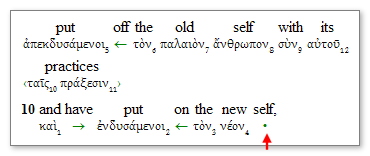(See also: RevInt I: Reverse Interlinears as Books and RevInt II: Reverse Interlinear Lines and RevInt III: Reverse Interlinear Symbols)
Occasionally, when I assemble a piece of furniture — say for instance a “Jerker” desk from Ikea, like the one that I sit at — I am left with a few odds and ends lying on the floor. Then I scratch my head and wonder, “Do I really need that lock washer?” The real question, of course, is: Do I really want to take the whole thing apart again to figure out where it goes?
Occasionally, when you are reading along in a reverse interlinear, you will encounter some of the nuts and bolts that are left over in the process of assembling the alignment. Here and there will be a round dot (bullet point) in either the original language line or the translation line of a reverse interlinear, indicating that no reasonable equivalent for that word could be found in the other text.
For the most part, our editorial philosophy for making these reverse interlinear alignments has been optimistic. That is, we assume that if the translation committee thinks they’ve translated the original language words of a particular verse, then we assume that they are. The goal, then, is to account for the translation, not to demonstrate elementary principles of Greek/Hebrew/Aramaic grammar. As a result, we give the benefit of the doubt in making links between the words of the original text and the translation. Our editors try — sometimes quite creatively — to account for all of the words in the translation. All of which tends, we hope, to minimize the presence of bullets in the text.
But they do happen, for various reasons.
Does this mean the translation is “bad” where you see bullets? Not necessarily.
(1) Language X has no word for Y
ESV OT Rev. Int. Genesis 1:2
The most common reason for the bullets are functional words in the original language text that are not usually translated into English. The Greek conjunction de is often not translated into English because it is required more often by the rules of Greek grammar than the equivalent conjunction(s) are in English; the Hebrew object marker (eth), on the other hand, is almost never translated, as in the example above from Genesis 1:2, because English has no equivalent function word for marking direct objects. (It is sometimes translated by for”, to”, or with”, but thats pretty rare.)
(2) Department of Redundancy Department

Another common reason for bullets to occur is pleonasm, that is, repetitions in the source that are considered unecessary in the translation. The phrase Jesus answered them, saying might just as easily be translated Jesus answered them”, and sometimes it is. In this case, the Greek word for saying is left with nothing to attach to in the translation, and so it gets aligned to a bullet point.
(3) To Be, or Not To Be


It goes both ways every now and then the translation adds something, either due to the rules of English grammar or to make explicit something that was left implicit in the original text. Many Hebrew verbless clauses, for example, need to have some form of to be added when translated into English in order to be grammatical sentences (eg, Genesis 1:2, Darkness over the face of the deep versus Darkness was over the face of the deep”). The same thing happens (albeit with less frequency) in Greek, as in Matthew 1:17, shown above.
(4) Clarity

Sometimes a word is added to the translation for clarity, as in Colossians 3:9b-10a in the ESV: seeing that you have put off the old self with its practices and have put on the new [self], which is being renewed ”. The second self is supplied for clarity, and as such is aligned to a bullet.
(5) Variant Readings

Sometimes, bullets arise because the translation comes from a variant reading that is not in the source text. For example, in the Old Testament, the ESV sometimes follows the LXX rather than the Masoretic Hebrew text. This is indicated in the regular (ie, non reverse interlinear) ESV resource with a translators footnote.





